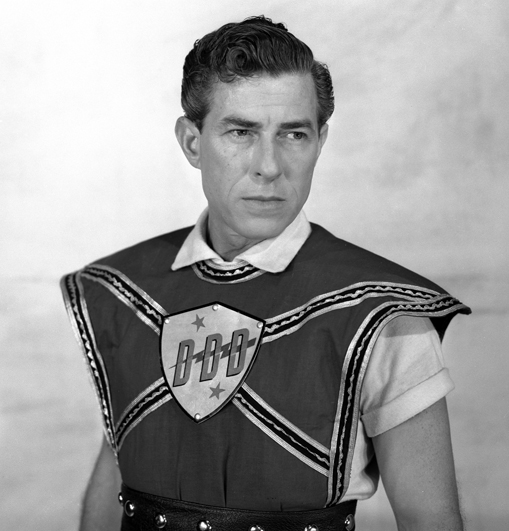
Ed Scott as "3-D Danny"
3-D Danny!
Buggsie and Muggsie!!
Windy West!!
Romper Room!
Let's start with...
3-D Danny
Channel 13's own Space Man

Ed Scott as "3-D Danny"
"Now it's time for the adventures of '3-D Danny', champion and defender of all that's good...but a relentless foe of all that's bad and evil." - Opening Narration for 3-D Danny voiced by Jerry Krumbholz.
3-D Danny was a classic example of a locally-produced children's program. The program mixed studio-based adventures and Warner Bros. cartoons to make a half-hour show weekdays on Channel 13. Sandwiched between The Mary Ellen Show and Pulse News, 3-D Danny offered a daily dose of outer-space mayhem that stretched the creativity of the production crew. And it was all done LIVE.
Danny broke the television's 'fourth wall' by starting each show with a friendly greeting to viewers. Even during his adventures, Danny would frequently address the camera to explain his predicament and what he might do about it. Starting with a two or three minute-long exposition scene setting up the day's adventure, Danny would then introduce a cartoon which was followed by a commercial. Often, Danny himself would deliver the sponsor's pitch. How he was able to do this during an adventure was never explained. After the commercial break the storyline would resume and before long Danny would be facing jeopardy from a space pirate or other menace. When Danny's situation turned sour and a beating was imminent.... time for another cartoon! After the cartoon Danny's cliff-hanger would be resolved and the adventure would continue...for another two or three minutes until the end of the half-hour. Storylines would often stretch over several days.
Channel 13's space man 3-D Danny was portrayed by staff announcer Ed Scott. A versatile broadcaster with a background in live theater, Scott brought considerable charm and wit to his spaceman alter-ego. His ability to ad lib during technical snafus was often put to the test. Scott was costumed in the then-current style of 1950's space heroes...a "V" patterned uniform blazoned with three letter 'D's' and a lightning bolt.
Helping Danny along in his star trek was a robot named 'Ruffnik.'
Danny and his robot "Ruffnik"
"Ruffnik's moniker was a riff on the name of the first Russian space satellite "Sputnik," launched the same year that 3-D Danny premiered on Channel 13. Constructed by the prop department at WKY-TV, Oklahoma City, and shipped to Channel 13 in a large, coffin-shaped crate, "Ruffnik" was a virtual duplicate of the robot used in the Oklahoma City version of 3-D Danny.
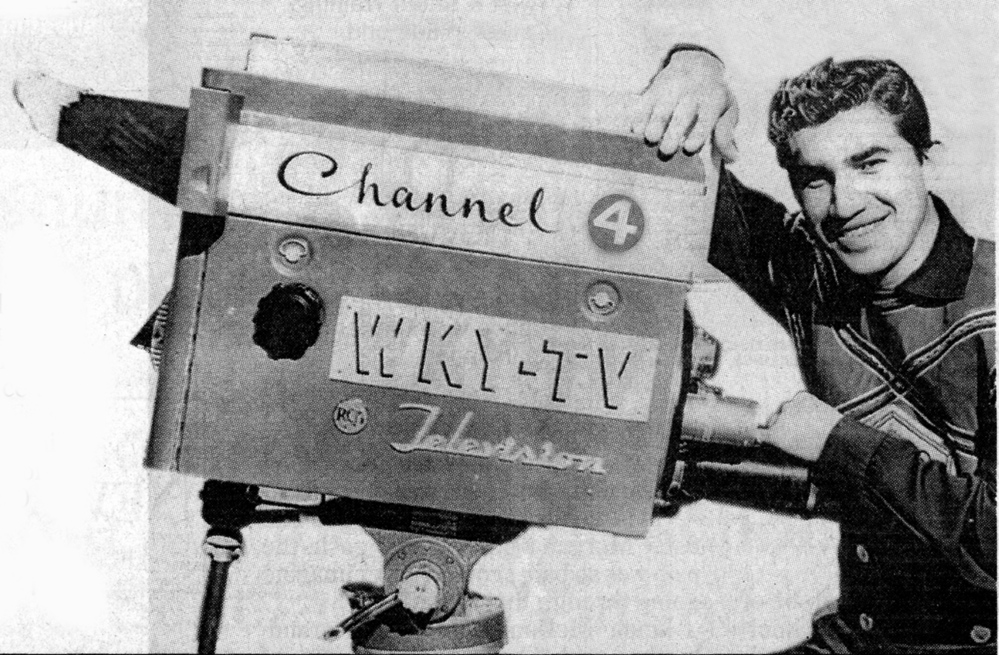
Oklahoma City's 3-D Danny, created and played by Danny Williams
3-D Danny was a program originated at WKY-TV and played by the station's own Danny Williams (see below for more details!). The show's format was copied for a version at WTVT and produced by Ken Smith, the station's production manager. Smith also wrote scripts and directed the show, which premiered late in 1957.
The question of who would operate the robot costume was answered when a young St. Petersburg Junior College student, Lyle 'Red' Koch (pronounced 'Cook') showed up at the station with his ventriloquist dummy 'Clyde.'
"Ken Smith set up an audition right away," recalls Koch. "I went into the studio…they pointed a camera at me, and I was just shaking in my boots…I was very, very nervous. I did my little act, and got a job. Not because I was a good ventriloquist, but because I could do a couple of different voices. They liked the voice of the dummy, and were looking for someone to play the robot on 3-D Danny. I never did any ventriloquism on television. I ended up getting in this silly suit and doing the voice."
'Red' Koch out of costume
Joining the cast of 3-D Danny was Red's first break in show business.
"They offered me the job and $5.00 per show," recalls Red. "I had my own car, and probably spent more on gas driving from St. Petersburg every day. There were no rehearsals. It was pretty much fly by the seat of your pants. Ed Scott was just terrific to work with. He was very funny, and a good artist…he did these wonderful caricatures. On the show, Ed knew what kind of lines to feed me and I'd try and make jokes out of them."
Danny's adventures took place on board a flying saucer set built in the southwest corner of Studio B. Corrugated fiberglass panels, the kind used for covering patios, formed Danny's set. For the control panel, a large U-shaped desk was topped with levers, buttons, and wild-looking instruments and gyroscopes. When Danny pushed a button it would activate one of a series of lights built into the front of the desk. Danny would have felt right at home on the bridge of Capt. Kirk's starship Enterprise.
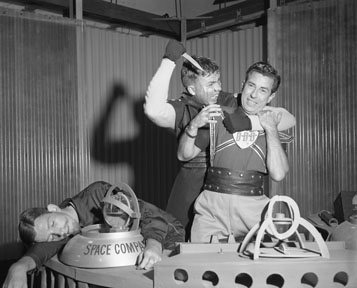
Mayhem on the set of 3-D Danny! Ed Scott is under attack by a space pirate.
The pirate is played
by WTVT cameraman Jerry Prater.
Lyle 'Red' Koch slumps over
the console. Note the studio walkway above the set.
The exterior of Danny's spaceship was 16mm stock film footage purchased from the MGM library...the same ship used in the classic SCI FI movie "Forbidden Planet," Galactic Cruiser C-57D.
3-D Danny's ship comin' at ya!
In an ingenious method of casting Danny's adversaries were often played by local wrestlers. In the late 50's and early 60's, Tampa was a popular stop on the professional wrestling circuit, and Channel 13's mobile unit was used for taping Championship Wrestling From Florida, hosted by Gordon Solie.
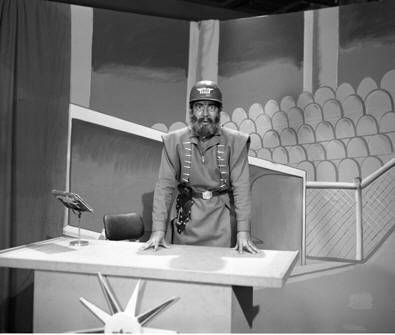
Villains were often played by wrestlers
Some of the 3-D Danny villains portrayed by wrestlers include "The Black Hood", "The Baron" (who had a black jumpsuit and moustache), and "The Count of Creton," who was bald-headed and wore a robe. For other roles almost anyone in the WTVT building would be called upon to act in the show. Danny was once pursued by a space-gorilla portrayed by Charlie Hampton, the station's public affairs director, who wore a rented costume. Cameraman Jerry Prater stepped in to threaten Danny with a knife in another outing. Producer Ken Smith's future-wife Jeri Bunt played a nurse in one segment.
Damage Control! A technician drops debris onto Danny's set
from the catwalk.
Note 'meteor' damage to front of Danny's desk...probably
the result of a collision with a camera pedestal
Because the show was live visual effects were kept to a minimum. WTVT's black and white cameras and switching equipment lacked the ability to Chroma Key (blue screen) and this forced the crew to keep things simple. By splitting the fader bars between two cameras on the control room switcher it was possible to superimpose one image over another, producing effects like an 'evil eye' floating in space.
Having a miniscule budget for props, the WTVT production staff would use studio equipment as stand-ins for futuristic devices. An
RCA microphone on a stand would be able to paralyze an enemy robot,
or a Mole-Richardson light would become a mind reader. Once, an ordinary
brick was able to 'absorb' the evil, floating eye!
One of Ken Smith's more ambitious producing efforts called for action underwater!
"I'd been out fishing with 'Salty' Sol Fleischman one day and I caught a baby octopus," recalls Smith. "We brought it back and I decided that the octopus would make a great sea monster adventure for Danny. I got an aquarium, filled it with water, and put this baby octopus in there. I went to the store and bought a toy submarine that looked like the Navy's Nautilus atomic sub. I used a 16mm camera and nudged the octopus with the sub. The octopus would grab the submarine and wrestle with it…turn it upside down…churn up the water. I got some really good footage. Then, we got film from Marineland of sea turtles and devil rays and stuff. I took all the film and spliced it together and put it on two projectors."
Danny fights a baby octopus in "Adventure of the Sea
Monster"
"I had Danny
live in a submarine set fighting the sea monster, and I'd cut to the
film of the octopus holding the toy sub.
We'd cut back and forth from the film to Danny falling around…I had
dramatic music going…I was like Cecil B. DeMille.
But I did not realize the Marineland film had an
audio track on it.
At the height of the drama, when I was ready to receive the Academy
Award,
a voice comes on and says 'If
you toss a few
graham crackers on the water, you'll notice how fast the fish comes to the
surface.
Well, (laughing) this went out on the air and I was devastated.
Welcome to live TV."
When the action called for location work, Smith would enlist WTVT's chief photographer, Jack Cosgrove, who would film the action with a 16mm film camera. Local quarries often stood in as the locations of distant planets.
Red Koch managed to get out of the costume occasionally to play Danny's young Lieutenant sidekick. He remembers that the production quality of the show improved as time went on. "Ken Smith wrote the scripts and directed, and the shows became a little more sophisticated and extremely popular. Kids would write letters to us…send in drawings of the robots and the puppets. It was a joy to know we were going to be on TV and the kids would be watching."
Ed Scott and Red Koch sort through viewer's entries
in a contest
to name the show's robot. The winning entry: Ruffnik!
3-D Danny lasted for almost three years. Station lore has it that the show was cancelled when Ed Scott returned from a location filming with muddy boots. Management refused to replace the boots and Scott resigned. No alien had been able to get Danny, but his muddy boots did! (this story was told to BIG 13 by several sources but we cannot provide direct proof that it is true)
Ed Scott departed Channel 13 and turned his attention to running "Edward's Pipe and Tobacco Shop," which is still located on Henderson Blvd. near Channel 13. According to Scott's partner at the pipe shop, Franklin "Smitty" Smith, Channel 13's spaceman never returned to performing and was content to run the store and its branch locations. Ed Scott and his wife Peg are deceased but you can learn more about them in an interview with Jackie Walker, who appeared regularly on Channel 13 with expert fashion advice. To read Jackie's story, click here for "Ed and Peg Scott...Before, During, and After WTVT"
Now, about the question What did the three "D's" in Danny's name stand for? BIG 13 asked Ken Smith and here's what he said: "3-D" stood for "Dan-D-Dynamo." I think Danny Williams from my old station, WKY, just made it up."
Mystery solved? You bet...and there's more! BIG 13 has been in touch with the ORIGINAL 3-D Danny, Mr. Danny Williams of Oklahoma City, OK.
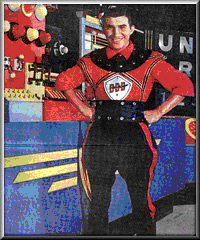
Photo courtesy Danny Williams
Mr. Williams is a broadcasting legend in Oklahoma, having
appeared on television and radio there for over sixty years. Danny hosted KOMA radio's number one rated morning show
until his retirement in August, 2008. BIG 13
was surprised and pleased to learn that Mr. Williams still proudly banners his
3-D Danny character. In fact, William's company is named "Dan D.
Dynamo Enterprises, Inc."! He even uses the old 3-D Danny shield as a
logo. You can learn about the original 3-D Danny (complete with color
photos) by going to Mr. Williams web site at www.dddynamo.com.
You can also see a seven-minute long 3-Danny clip from the WKY version.
Follow this link to YouTube:
http://www.youtube.com/watch?v=9YdxWJKOCHI
PULSE EXTRA! Here's a 3-D Danny anecdote from Channel 13's former news director and general manager, Crawford Rice:
"I saw the shenanigans that went on with 3-D Danny. 3-D Danny and Mary Ellen were both done out of the same studio, one right after the other, live. One day, Danny was right in the middle of one of his 'emotes.' He'd be down on one knee and somebody was about to zap him with a ray gun, and the studio door opened and Mary Ellen comes in with some live ducks…all quacking. 'Quack! Quack!' Danny's there with his brow furrowed, and pleading for his life, and in the background you hear this 'Quack! Quack!' That's the beauty of live TV…things like that happened all the time."
PULSE EXTRA EXTRA!
Former Channel 13 cameraman Nick Stratman has sent an original 3-D Danny
script! Here's an excerpt:
1959 3-D Danny script.
To learn more about 3-D Danny, go to "Ken Smith on 3-D Danny and his 12 years at WTVT"
To learn more about Red Koch, go to "Red Koch"
BUGGSIE AND MUGGSIE
Buggsie and Muggsie, two of WTVT's most
cost-effective stars...
only $1.50 each at Grand Way!
Buggsie and Muggsie were puppet pioneers in the sense that their humor was almost Muppet-like (years before the Muppets had their own show). Buggsie, with his large, bulging eyes topped by curved, black eyebrows, a pointed bird-like beak, and a feather emerging from the top of his head, was the alpha male, totally in control and always bullying poor Muggsie. Muggsie was a rounder, dopey-looking kinda guy who appeared to have some dinosaur in his family tree...he sported a single pointy scale on his head. Despite his dominance by Buggsie, Muggsie often won their bouts through passive-aggressiveness.
The puppet duo were the creation of 3-D Danny's Red Koch: "I started thinking that I couldn't play a robot all my life. One day I was in a store and saw these two hand puppets…and I bought 'em. My hands are a little on the small side, so they fit into these puppets made for kids. But the puppet's sleeves weren't long enough for television, so I got some striped cloth to extend the sleeves all the way up my arm. I started playing around at home trying to develop personalities so they could have conversations. Muggsie was slow witted, and Buggsie was the wise guy. I showed them to Ken Smith and he put me on with Mary Ellen. She would come over, like Kukla, Fran, and Ollie, and talk to the puppets. The puppets would misbehave and Mary Ellen would try to teach them some manners."
When Channel 13's program director Bob Olson bought the syndicated The Three Stooges' program, he named Buggsie and Muggsie as the show's hosts. Red got a raise to $37.50 per show and decided to break the fourth wall of television puppetry. "I got tired of them being confined to a puppet stage. I talked to the director and told him I wanted the puppets to leave the stage and walk around the studio. They could go over to the news set or into the hall or the control room. I told the cameraman to make sure he didn't shoot me…to just keep the puppets in the shot. I crawled on my belly or slid on my back…a stool with wheels would have been a luxury. I had my lavalier microphone on, and we broke the rules for puppets on TV."
As Red Koch mentioned, Buggsie and Muggsie were off-the-shelf puppets purchased from a local store. They were in fact designed by the legendary puppeteer Bil Baird, manufactured by Ideal Toys, and sold in retail stores and toy catalogs throughout the country as generic puppets. The upside of Red's decision to buy off-the-shelf puppets is that any child could own an EXACT replica of B & M for around $1.50 each!
Lyle "Red" Koch was the man behind Buggsie and
Muggsie.
PULSE EXTRA: Red Koch talked with BIG 13 in more detail about his time at Channel 13. To learn more about Red, CLICK HERE
'Windy West'
(Photo and article courtesy Jim Maloy)
During the station's freshman year a package of western movies was hosted by 'Windy West,' the creation of Herb Buck from Channel 13's traffic department. Appearing weekdays at 4 o'clock (4:45 on Fridays), 'Windy' would introduce the day's story and draw on his 'extensive' background as gold miner, cattle puncher, ranch roustabout, and chuck wagon cook.
According to a 1955 article in The Tampa Times, 'Windy' offered a passing knowledge of trick riding, stagecoach guarding, and cattle branding. For a short time, 'Windy' was also a frontier lawyer. He carried a bullet in his knee, picked up during a furious gun battle with some renegade rustlers in the Pecos River section of Texas.
'Windy' also provided some safety advice for his young viewers, only couched in western terms: "Stay out from under the wheels of stagecoaches."
Windy's time on Channel 13 was brief, from August 8, 1955, to
October 28, 1955. And they say today's programmers don't give shows a
chance!
'Romper Room'
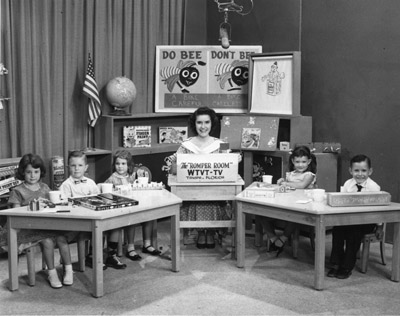
Colleen Paglen was "Miss Connie" on WTVT's version of Romper Room
Just about every TV market had a version of Romper
Room, a pre-Sesame Street program for the kindergarten set. Created by Claster Television
in the early 1950's and licensed to TV stations across the nation, the Tampa Bay version started
with Colleen Paglen on WTVT. Each weekday morning from 9-9:30 "Miss Connie" would guide six
pre-schoolers in a program of songs, stories & games.
The Paglen-hosted Romper Room ran from October 31, 1955, until April 26, 1957.
At that time "Miss June" Hurley became the host and the show moved over to WFLA
on January 12, 1959, and ended May 19,1961.
At some point thereafter, Romper Room moved to Channel 10 and June Hurley
resumed her
tenure as the shows host. (Ms. Hurley
married and became June Young by the time of the Channel 10 Romper Room).
To return to "Capt. Mac and Other Bay Area Kids Show Hosts"click here
To return to main menu, click here